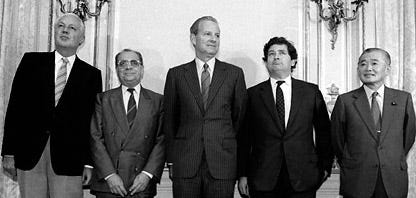The floor-to-ceiling analysis on Trump's tariff war
Is he capable like James Baker or incompetent like Herbert Hoover? And did Trump just blink?
I know, I know. Even claiming there is a range of possible analysis on Trump pisses off a lot of people, but there is sound logic in imagining best and worst-case scenarios — as always.
Let’s start with the happy talk.
What if Donald Trump is crazy as a fox — like Jim Baker in his Treasury days under Reagan?
This is the story of the Plaza Accord, from Wikipedia.
Plaza Accord
The Plaza Accord was a joint agreement signed on September 22, 1985, at the Plaza Hotel in New York City, between France, West Germany, Japan, the United Kingdom, and the United States, to depreciate the U.S. dollar in relation to the French franc, the German Deutsche Mark, the Japanese yen and the British pound sterling by intervening in currency markets. The U.S. dollar depreciated significantly from the time of the agreement until it was replaced by the Louvre Accord in 1987. Some commentators believe the Plaza Accord contributed to the Japanese asset price bubble of the late 1980s.
Point being, the dollar got out of whack with the rest of the West’s major currencies, to the disadvantage of the US. Now, the US could have thrown a fit, picked a fight, bloodied a nose or two, and risked derailing a reasonably good West economic situation then (nobody talked about a global economy in 1985), but, instead, Baker did the Godfather trick of bringing the Five Families together and working out the beef — calmly and quietly.
Think of the Corleone family as America and the Tattaglia family as China.
This isn’t personal, this is business.
BARZINI: Certainly, he can present a bill for such services. After all, we are not communists! [laughter around the table]
This is total great-power collusion — the best sort: admit a mutual problem, come together, skip all the histrionics, and make the deal everybody knows needs to be made to keep the peace and keep growing the pie.
Who would need to be sitting around that table today? Think of the five families as the US, Canada, Mexico, China, and the EU.
The Plaza Accord wasn’t a one-off either, as noted above — there was a follow-on tweak two years later (again, from Wikipedia):
The Louvre Accord (formally, the Statement of the G6 Finance Ministers and Central Bank Governors) was an agreement, signed on February 22, 1987, in Paris, that aimed to stabilize international currency markets and halt the continued decline of the US dollar after 1985 following the Plaza Accord. It was considered, from a relational international contract viewpoint, as a rational compromise solution between two ideal-type extremes of international monetary regimes: the perfectly flexible and the perfectly fixed exchange rates.
The agreement was signed by Canada, France, West Germany, Japan, the United Kingdom, and the United States. The Italian government was invited to sign the agreement but declined.
So, Plaza Accord to depreciate the dollar, and the widely-known-as-the Reverse Plaza Accord to stop the dollar’s depreciation.
See the below citation, which I was waiting to appear independently because I was worried that I was out of my economic depth here and was, in effect, comparing apples to oranges. It suggests that Trump the Mastermind is actually seeking some Mar-a-Lago Accord with the right package of “families” agreeing on a wide adjustment of tariffs among them — here, in effect, depreciating the dollar so our exports can grow while our imports shrink.
NYT: There’s a Method to Trump’s Tariff Madness
The logic:
Mr. Trump’s tariffs aren’t really about tariffs. They are the gambit in a more ambitious plan to smash the world’s economic and geopolitical order and replace it with something intended to better serve American interests.
This plan is often referred to as the Mar-a-Lago Accord. Apparently devised by Mr. Trump and two of his top economic advisers, Treasury Secretary Scott Bessent and Stephen Miran, the chairman of the White House Council of Economic Advisers, it seeks to improve the United States’ global trading position by using tariffs and other strong-arm tactics to force the world to take a radical step: weakening the dollar via currency agreements. This devaluation, the theory goes, would make U.S. exports more competitive, put economic pressure on China and increase manufacturing in the United States.
Such analysis can seem counterintuitive: The problem with Trump’s approach is the negative dynamics surrounding tariffs, which themselves tend to strengthen the dollar in the short term. During any trade war initiated by us, US tariffs reduce US imports, shrinking demand for foreign currencies and bolstering the dollar’s value — making it stronger. Similarly, retaliatory tariffs reduce demand for US exports, potentially offsetting gains from a sought-after weaker dollar. Additionally, larger forces, like investor sentiment and monetary policy, can overshadow exchange rate adjustments.
Then there’s the big difference between now and 1985, per the NYT piece that explicitly references the Plaza Accord:
Unlike in 1985, large numbers of U.S. dollars today are held by China. Lowering their value would amount to financial warfare with China, which the plan endorses … Much as the Cold War arms race with the Soviet Union squeezed the Communist system to the point of collapse, this strategy seeks to cut off China from the world economy through punishing tariffs or a user fee on reserves, which would eventually force transformative change.
If everything goes as planned, U.S. exports would be more competitive globally, China would be weakened, and more of our allies would be sharing the burdens of military spending. The upshot would be more manufacturing in the United States and a reinvigorated American heartland.
So, as always with Trump, there are hints of a higher logic, but the execution is always tethered to his erratic nature: like stacking tariffs upon tariffs for imports from China, bringing that nation’s total up to 125% (theoretically) and eliciting a counter-escalation by Beijing in slapping — what ends up being as of yesterday — an 84% tariff on all imports from America, a total tax I would expect to rise any hour.
Whew! Says I.
Then they are the collateral casualties, like, during Trump 1.0, when US farmers lost — seemingly forever — their previously dominant soybean market share in China to Brazil, which is slated to clean up even more this time around. Already (h/t brother Andy), we’re seeing similar market losses arise in energy:
JOHNMENADUE.COM: US LNG crippled as Australia seizes US$1.5b trade overnight
Oops! He did it again!
You mess with people’s food and energy and they will no longer trust you as a trade partner — simple as that.
You get the feeling that a lot of Sonny Corleones are going to drop on our side if this fight goes on for too long without the Big Deal coming together somewhere (maybe a third party great power suggests and convenes and sherpas the whole thing?).
So, glass-half-full says, give the Great Man some more time for his genius secret plan to play out.
I know. It’s like the piece I wrote for Politico in January: any rational person looking at this seemingly crazy strategy wants to impose some logic on it. With me, I feel like the exogenous forces working the collision of climate change and demographics are huge and inescapable, whereas here, the dream of re-industrializing America and somehow vaunting us to the top of the global manufacturing heap on that basis … well, it is kind of crazy because it just won’t happen and wouldn’t benefit us much even if it did.
I don’t want America to dominate low-end manufacturing this century. That isn’t an answer to any of our problems. Technologically, it’s also a strategic dead-end.
So, one naturally retreats to the glass-half-empty comparison: Trump is another Herbert Hoover — a “genius” businessman who is simply ill-placed in the White House.
Understand, we’ve now had two GOP business leaders as presidents: Hoover with the Great Depression, Trump 1.0 screwing up the COVID response and waging a mini-tariff war that won us nothing and cost plenty in lost overseas markets, and now Trump 2.0 that seems intent on losing far more while possible triggering a global depression.
Then there’s the similar reliance on tariffs: the Smoot-Hawley Act detonating what remained of a cratering global economy in 1930; and Trump’s current Scott-Pilgrim-vs.-the-world strategy that myopically focuses on the “beauty” that are tariffs.
Then there’s the strong identification of the problem with the one man: Hoover refused to care or do anything about the Great Depression, believing it not to be the job of the president to intervene in that manner. That got him Hoovervilles (or homeless camps) all over America.
Nice.
Now, we see Trump 2.0 gutting the Federal government right as he plunges our economy headlong into a seemingly suicidal free-fall — one man creating all this damage based on one bad idea!
Sure, Trump keeps teasing retreats — like his 90-day pause announced Wednesday for a slew of countries described as negotiating with the US right now. Expect, in coming days, for there to be a string of White House-announced “tariff victories” with any number of those negotiating nations. But none of them will add up to a changed US trade landscape. That can only happen if the equivalents of the Godfather’s five families come to the table — at Mar-a-Lago or somewhere like it, to hammer out a comprehensive deal.
Again, those five families would be the US (of course), the EU, China, Mexico and Canada. For now, only Mexico seems in the compliant negotiating mode, so this fight will rage on, with no amount of smaller side deals arresting this dangerous momentum that now sees US bond holders worldwide shedding those assets and thus signaling a diminished world faith in the sanctity of US sovereign debt. If you want to know why Trump blinked with his 90-day pause, it was that dynamic in the US bond market that finally freaked him into backing down.
Trump blinks and the Dow surges in response. Ring that bell and Pavlov’s dog salivates, alright, but no victory to be found here, because what does that “blink” tell China? It tells China that, this is how you scare Trump into backing down— by threatening the US bond market just as Trump plans to add trillions to the national debt. That would be Beijing grabbing the US economy by the you know what — just like Trump thinks he can do to the world with tariffs.
Trump’s ongoing flirtation with national economic suicide by tariffs reminds me of that would-be finale Futurama episode titled "Meanwhile," where our hero Philip J. Fry becomes trapped in a 10-second time loop during a suicide attempt. Believing Leela has rejected his marriage proposal, Fry jumps off the Vampire State Building. Mid-fall, he realizes his watch is fast and Leela is actually on time. He tries to use Professor Farnsworth's time button to reset himself to safety, but since it only rewinds 10 seconds and takes that long to recharge, and Fry’s already been falling for more than 10 seconds, he remains stuck falling endlessly in a nightmarish do-loop
Having already cited The Godfather, Scott Pilgrim, and Futurama … I am almost out of deep-cut arrows in my quiver!
Alas, all such efforts to rationalize and contextualize Trump 2.0 end up spinning their wheels. No one historical analogy can suffice, so we keep kluging them together, like a bunch of sad pop culture references.
The inescapable truth remains: Trump is too small a figure for this great moment in history.
Until we get better, next-generation, truly visionary leadership (think Picard plus Data as a necessary upgrade from Kirk plus Spock), we’re going to keep splattering on the pavement like Fry, wondering how we escape this disastrous do-loop.
Ah! That final Star Trek reference completes me … while convincing another fed-up subscriber that I can’t take it anymore!









Trump, taking a page from autocrats everywhere, is an appetite, always on the make for "more". Tariffs are used, at the moment, to push the visage of the Great Man into ever living room on earth. Trump making motions to "solve" his self-made crises, one performance at a time, feeds the devoted with tales of his superiority, and sates the Great Man's need to be "seen".
Beyond this self-adulation, there's not much. I agree that there is a heavy inspiration to want to impose some kind of order on Trump's erraticism. I believe that is a fool's game.
With tariffs, Trump has merely found a great well of assets and is proceeding to gamble with these until it's not fun anymore. This is a guy who, when he put his mind to it, was able to enjoy 6 bankruptcies. Now he's in a larger economic environment. The appetite is the same. He just has a larger pot, and bonus(!), it's someone else's money!
This may stumble downhill long enough to generate this "5-families" kind of "solution. The way an avalanche carefully rearranges a mountainside. Trump will stand aside from all the destruction and declare victory. His minions, having failed to oppose any of his actions will be compelled to salute.
China, for its part can do what the US did prior to WWII. Stand back and wait for the rubble to settle, then step in with a "new world order". The "catch" for China is its dependency on domestic consumption. This weak flow cannot sustain Xi's plans. There appears to be no economic well-spring Xi can appeal to to float his vision of Chinese Centrality and a Xi-led future.
Putin, well, his Russia is a gas station with nuclear weapons. Any participation by Russia in a 5-families "solution" would be one no one would be inclined to sustain. So, spoilers, any 5-families "solution" would also need to effectively manage the two (so far) nuclear wild-cards (Russia, North Korea) who would feel both left out, and provoked by being left out.
Autocrats tend to not understand the concept of "earning".
As Trump renews his efforts to burnish his self-image in his mind-mirror, America may become aware that Trump is in fact spending American "resiliency" in his question for self-adoration. Whether this inspires appropriate push-back or viable objections, which could flower into a course change more favorable for the nation, is an open question.
interesting read
on trumps motives... something I read last week will stick with me for a bit...
"some like to suggest that Trump is playing 4D chess despite the fact that nobody can ever recall a time he played or succeeded at 4D chess"
i think one of the political talents of Trump is that he can take any situation and make it seem like it was his plan all along.... but I often feel his plan is just to let his advisors run amok as he figureheads above it all, intervening only when the game is really on the line
if i read the headlines with any other mindset i get a headache